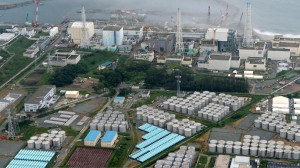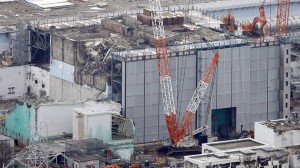 While reading about the Fukushima reactor disaster that continues to impact us, I sought someone to blame, someone to hold responsible. Like many people, I want to blame TEPCO, the electric company that owns and runs the reactor and now, the government of Japan for not regulating and monitoring industry safety and the dysfunctional clean up effort. I thought about what blaming them would look like and how it might help.
While reading about the Fukushima reactor disaster that continues to impact us, I sought someone to blame, someone to hold responsible. Like many people, I want to blame TEPCO, the electric company that owns and runs the reactor and now, the government of Japan for not regulating and monitoring industry safety and the dysfunctional clean up effort. I thought about what blaming them would look like and how it might help.
In the case of a corporation like TEPCO, we could fine them a lot of money. That is the course we usually take with corporations. The fines are our collective approach to punishing them and compensating those negatively effected by the corporation’s actions. Since TEPCO reactors have caused tremendous and perhaps permanent damage to millions of people and the vast number of life forms living the Pacific Ocean, it seems that any fine would be have to enormous to even come close to the cost of the damages incurred. Let’s go with that then. It seems fair, huge damage, huge fine.
The largest fine that could be assessed would be equal to the total value of the company. After all, they can’t pay more than they have. If they are like most large companies, they keep a relatively small amount of liquid assets on hand, usually just enough to cover ongoing expenses like payroll, utilities, etc., operating costs. The rest of their assets are in held in the form of the land, buildings and infrastructure used to provide, in this case, electricity. So if we assessed the largest fine possible, it would equal the total assets of the company.
 In order to pay this fine, the company would have to sell off its assets because the cash on hand would pay only a small fraction of the fine. Now this is where it gets interesting. How do you suppose a company like TEPCO could sell its land, building and infrastructure? First of all, who or what would have the resources to pay for such a huge purchase? Such a purchaser, even if they exist, would not buy the assets. Why? Well, the fact that this disaster occurred and the impact it has had calls into question the viability of the entire nuclear power industry. In other words, TEPCO’s assets only have value to the extent they can produce a profit. Once TEPCO’s basic operating assumption – that nuclear power can provide power efficiently and safely – is invalidated, the value of its assets plunges to near zero.
In order to pay this fine, the company would have to sell off its assets because the cash on hand would pay only a small fraction of the fine. Now this is where it gets interesting. How do you suppose a company like TEPCO could sell its land, building and infrastructure? First of all, who or what would have the resources to pay for such a huge purchase? Such a purchaser, even if they exist, would not buy the assets. Why? Well, the fact that this disaster occurred and the impact it has had calls into question the viability of the entire nuclear power industry. In other words, TEPCO’s assets only have value to the extent they can produce a profit. Once TEPCO’s basic operating assumption – that nuclear power can provide power efficiently and safely – is invalidated, the value of its assets plunges to near zero.
Sure, some of its assets like office buildings and land not located near reactors or fuel storage facilities would still hold significant value, but it would be nowhere near sufficient to pay off a huge fine. Oddly enough, the very recognition of its failure and its responsibility to pay damages eliminates the possibility of recouping funds or penalizing the corporate culprit. Not only that, such conviction and assessment of monetary penalties impacts the value of other companies in the same industry. After all, a disaster could befall them as well at any time.
Given the economic system we have, it becomes apparent that our ability to impose meaningful monetary punishment on any corporation is severely limited. No matter what damage or destruction they cause, any attempt to “punish” them monetarily in any significant way is doomed to failure because the process used to punish them diminishes their value and thus their ability to pay. It is clear then that there is no effective way to control the actions of or mitigate damages caused by large corporations except when the damages are minor and easily paid from operating funds. Once an assessment is large enough to threaten the existence of a corporation, it can not be paid.
 To get back to the Fukushima disaster, what can be done? Obviously, there is no way to recoup the cost of the damages from TEPCO. But what about the government of Japan? Well, they have assets too, much like a large corporation. Thus the concept of selling off assets is an option and perhaps they have sufficient value to raise the money needed to pay for the on going damage. However, doing so would require selling parks, buildings and infrastructure to other corporate entities which would perpetuate the circular corporate responsibility concept I have been talking about here. Another option, and one that most governments use, is issuing debt in the form of bonds, borrowing the money. But again, there are issues with this too. At some point, the ability of the government to pay back the money it borrows will diminish because of the damage to the country from the TEPCO disaster. Investors might feel that lending money to deal with an ongoing radiation disaster that has no solution in sight, might be just too risky. Who knows.
To get back to the Fukushima disaster, what can be done? Obviously, there is no way to recoup the cost of the damages from TEPCO. But what about the government of Japan? Well, they have assets too, much like a large corporation. Thus the concept of selling off assets is an option and perhaps they have sufficient value to raise the money needed to pay for the on going damage. However, doing so would require selling parks, buildings and infrastructure to other corporate entities which would perpetuate the circular corporate responsibility concept I have been talking about here. Another option, and one that most governments use, is issuing debt in the form of bonds, borrowing the money. But again, there are issues with this too. At some point, the ability of the government to pay back the money it borrows will diminish because of the damage to the country from the TEPCO disaster. Investors might feel that lending money to deal with an ongoing radiation disaster that has no solution in sight, might be just too risky. Who knows.
The bottom line is that we as a society can not rely on monetary remedies to control corporate behavior, even when this behavior causes massive damage to life on this planet. When unrestrained corporate behavior results in disaster, using a commensurate monetary assessment to extract punishment damages or kills the corporate goose which is laying the golden egg we expect to receive. This leaves us with two unsatisfactory options. Either we limit the assessment of fines such that corporations can pay them from its profits without damaging the asset base it uses to generate such profits (as we did with BP in the Gulf of Mexico), or we must be content with shutting down large corporations and entire industries with little expectation of compensation. This later option would require major changes in how we meet our needs for energy, food, clothing, shelter and the other necessities of life. Ultimately, I think this is our only viable choice, the only way to avoid the annihilation of life on the planet. There really isn’t another option.